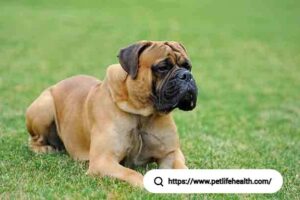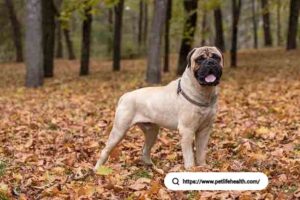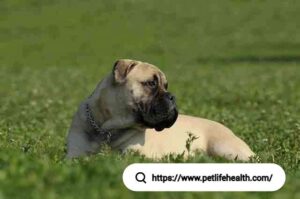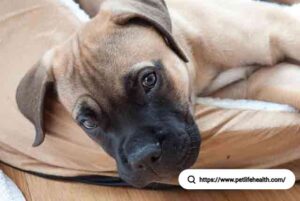We must explain to you how all seds this mistakens idea off denouncing pleasures and praising pain was born and I will give you a completed accounts off the system and expound the actually teaching.
Business
Bullmastiff Dog Breed Characteristics and Many More 2025
Bullmastiff Dog

The Bullmastiff Dog is a large-boned, muscly working dog with a short coat that was developed in England by crossing Bulldogs and Mastiffs. They were developed to guard rural properties and deter poachers. These big canines with narrow muzzles were capable of running swiftly enough to capture a poacher and hold him down until a gamekeeper could step in. Later on, they gained popularity as additions to English dog exhibitions.
Its look makes it clear that it is a product of a Mastiff and bulldog hybrid. This breed is loyal, perceptive, and intelligent. Despite having a strong urge to guard, Bullmastiffs are normally quite gentle with kids and other non-threatened individuals.
Bullmastiff Appearance
The Bullmastiff Dog is a handsome dog with his large, massive head held high and a keen look. His strong, wide legs support his large chest, broad shoulders, and sloping hindquarters. He received a square, muscular physique from his mastiff ancestry, and when his tapering tail whips at full speed, it wiggles a little.

His shorter black cube-shaped nose and the furrows that span it reveal his bulldog heritage. He isn’t as depressed as he seems; in fact, the reverse is true. However, in typical bully form, his jowls droop with a little scowl, and his rounded, deep-set brown eyes seem a touch melancholy.
Usually fawn or red with black highlights around his eyes and inking his V-shaped ears as they point down the side of his cap, a bullmastiff has a silky, thick, and short coat.
Large dogs are a breed called bullmastiffs. Males are between 25 and 27 inches tall and 110 to 130 smackers in bulk. Females stand between 24 and 26 inches tall, weigh between 100 and 120 pounds, and are somewhat shorter. Bullmastiff puppies typically weigh between 34 and 43 pounds at three months old. Puppy bulks should range from 63 to 77 quid. A Bullmastiff will reach full maturity at the age of 19 months.
Features:
Droopy eyes, floppy ears (naturally)
Expectations:
Exercise Requirements: 40 minutes/day
Energy Level: low to moderate
Longevity Range: 8-10 yrs.
Tendency to Snore: High
Tendency to Drool: High
Tendency to Bark: Low
Tendency to Dig: Low
Social/Attention Needs: Moderate
Bullmastiff Personality:
The Bullmastiff Dog Family members are preserved kindly and warmly by bullmastiffs. They are suitable canines for families with children who are often well-behaved due to their normally calm and laid-back traits. When a stranger is around, the Bullmastiff’s relaxed demeanour among family members is likely to alter. These dogs have a propensity to be quite wary of strangers.
Despite his devotion to his family, the Bullmastiff is no coward. He has a propensity to think independently, which can make exercise difficult. He could also be less thoughtful of an animal family’s members than of its human ones. If you’re seeing getting a bullmastiff for your group, use care.
Bullmastiff Temperament
The Bullmastiff Dog’s massive frame hides a calm cuddle bug who longs for your company. A bullmastiff will normally want to be in the same room as you, maybe even at your feet, next to you, or even on you as much as he can. However, each puppy’s disposition is different.

However, this behaviour is not always the case. A bullmastiff may become his best self with appropriate no-fear and positive reinforcement training, commencing when he is approximately 10 weeks old and after his vaccines are finished. This is true of many working dogs as well as dogs in general. According to Smith’s observations, a bullmastiff must possess a particular human temperament in order to survive in a family setting. The greatest candidates would be those who are at ease setting reasonable standards for conduct and training and who consistently follow through.
Even though a bullmastiff may have a calm and kind demeanour, he nevertheless weighs more than 100 pounds and has a lot of energy that has to be contained with gentle but strong training.
With a bullmastiff, training should begin with early boundary establishment and should go beyond socialization and puppy kindergarten. Continue your teaching by giving him regular refresher courses so he is always aware that he is not the family’s leader.
Your Bullmastiff has to be socialized in order to develop rose-coloured glasses, according to Krista Sirois, DVM of Florida Veterinary Behavior Service: He should view new people, animals, and circumstances as positive things.
Sirois asserts that socialization is crucial for all breeds, but it becomes much more crucial for dogs above 120 pounds. “You want to make sure you are aware of your dog’s manners and their level of fearlessness.”
Bullmastiffs, in Smith’s opinion, are not the greatest breed for first-time dog owners because they “have a hard time with ‘no’ sometimes meaning ‘maybe,’ they tend to be extremely literal in that sense, and being inconsistent sets them and the family up for unreasonable expectations.”
In distinction to other occupied dogs, bullmastiffs don’t require regular periods of vigorous activity in order to be healthy and behave themselves. Even daily walks and positive support of positive behaviours should keep your Bullmastiff happy. But it’s crucial to develop his intellect and innate skills through agility races, tracking activities, or treatment dog training.
Although bullmastiffs are renowned for being gentle giants and are often silent hounds with little bark, there is no need to question their watchdog skills. He is devoted to his family and will let you know if anything appears out of the ordinary because he has a history of searching vast rural estates with game masters for poachers. As with any dog, socialize your Bullmastiff to teach him how to behave around everyone, even guests.
Bullmastiff Living With
The Bullmastiff Dog will be a kind, devoted member of the family. Although the dog’s typically laid-back character, nursing is necessary when the dog is around kids since the dog is so big that it may accidentally knock a kid over. Drill and socialization are vital for a good coexistence with this breed. The dog may develop less wary of strangers and guests if you expose him to as many different people, places, and circumstances as you can, especially while he’s a puppy. He sheds little and has minimum care requirements because of his short coat.
If you plan to accept a bullmastiff, consider getting him a bib because these dogs regularly slobber and drool. They are famous for snoring as well. The Bullmastiff doesn’t live as long as smaller dogs do, which is typical of most very large breeds. A person may be supposed to live for eight to ten years on a regular.
Bullmastiffs and Children
The Bullmastiff Dog may make an awesome family pet if it is raised alongside a youngster. They may be highly loving and need to continue to the members of their family. It is significant to highlight that Bullmastiffs lack trusting relationships, which might be problematic when kids invite friends around.
Dogs similar to Bullmastiffs
The Bullmastiff Dog It’s stimulating to note that three dog sessions—Boxers, Bulldogs, and Tibetan Mastiffs—have traits mutual with Bullmastiffs.
• Boxer: Bullmastiffs and Boxers were both industrialized as working breeds. They both have modest sheds and are rather simple to groom. Boxers are smaller than Bullmastiffs, though. Male Boxers classically weigh around 65 pounds, but male Bullmastiffs often weigh around 120 pounds.
• Bulldog: One of the two breeds used to create the Bullmastiff was the bulldog. They share the Bullmastiff’s short muzzle. Both dogs are adorable but may have parting worries if left alone for a long period. Bulldogs are much smaller than Bullmastiffs. A male Bullmastiff typically weighs 120 pounds, compared to a Bulldog’s average weight of only 54 pounds.
• Tibetan Mastiff: Even better than Bullmastiffs Are Tibetan Mastiffs. Linked to a male Bullmastiff’s 120 pounds, their typical weight is 155 pounds. Additionally, Tibetan Mastiffs bark more frequently than Bullmastiffs do. Both dogs have a strong wisdom of territory. Both of them would be great family dogs.
History of The Bullmastiff Puppy
The Bullmastiff Dog Midway through the 1800s, the Bullmastiff breed was established in England. Gamekeepers experimented with cross-breeding because they required a canine to guard their prey from poachers. Bulldogs were far more courageous and vicious than they are now, yet the breed was too tiny to take down a person. Although the mastiff was too big and sluggish for the role, a hybrid between the two breeds produced the perfect guard dog. The hue brindle was picked because it offered built-in concealment. To protect the De Beers diamond mines in South Africa, this breed was brought.
Even while it still makes a great guard dog, the Bullmastiff is now more commonly recognized as a superb family dog and a loving companion. The American Kennel Club (AKC) first recognized this breed in 1933.
Bullmastiff Care
The Bullmastiff Dog are great family pets since they are gentle friends and guardians. When taught and socialized correctly, they get along great with kids. Large dogs are more likely to knock down little children or respond aggressively if a tiny child treats them badly. When the dog is about new broods, keep an eye on them, and you might need to put off receiving a Bullmastiff until your kids are older.
They favour sharing a home with others, but they can handle a situation in which their family members are away at work as long as they receive attention both before and during the absence. However, if a bullmastiff is kept in a yard by itself, deprived of access to family, they may exhibit certain negative traits. The Bullmastiff is, above all, a loving and keen home pet that develops a strong attachment with its owners.
A bullmastiff won’t require much upkeep, but because of his slobber and farts, he isn’t always the nicest friend. He has a flat, brachycephalic face and dribbles often. His eating habits also put a strain on his digestive system and result in foul odours. A veterinarian may offer guidance on how to keep his mask folds clean, teach you how to wipe up dribbles and suggest diets for, well, the other things.
Up to the age of two, your bullmastiff puppy will grow (and grow quickly!). To assist in safeguarding his joints, Siros advises giving him large-breed puppy food rather than standard puppy food.
He will occasionally shed, especially in the spring and fall, but a weekly short brushing will keep him looking tidy. Bath him if he doesn’t smell very fresh. A bullmastiff looks sharp when given regular dental treatment, nail trimming, and ear inspections.
Bullmastiff Health Problems
The Bullmastiff Dog Breeders that practice responsible breeding work to uphold the highest breed standards as set out by organizations like the AKC. These breeding rules reduce the probability of inheriting health issues in dogs. However, Bullmastiffs are susceptible to several inherited health issues. There are a few things to be mindful of, such as:
Hip dysplasia: A disorder when the hip sockets develop improperly.
Ruptured cruciate ligament: The ligament that links the front of the tibia to the rear of the femur is torn partially or completely.
Gastric dilatation-volvulus: An illness where the stomach of the dog swells and twists.
Ectropion: A prevalent disorder when the lower eyelids roll out or droop.
Bullmastiff Exercise
The Bullmastiff Dog Although the Bullmastiff is not a very active breed, it nevertheless requires regular exercise to be healthy and motivated. Take your dog for a few daily strolls, and from the time they are puppies, begin proper leash training. When the Bullmastiff reaches adulthood, it will be so big and strong that you will struggle to control it if it tugs on the leash. Additionally, it’s doubtful that these dogs would get along with other dogs if they were permitted to run loose at a dog park. The Bullmastiff’s small nose makes it susceptible to overheating. Avoid over-exerting yourself, and be sure to keep your dog cool in the summer.
Bullmastiff Grooming
The Bullmastiff Dog has a short coat that usually requires basic maintenance. This breed sheds only a little bit on average. In addition, the skin folds on the Bullmastiff’s face (if any) should be maintained dry and clean. Because this breed tends to drool, you should always keep a slobber cloth with you when it shakes its head.
Your dog should be able to naturally wear down its nails via exercise, but if you hear clicking on the floor, examine them and clip them. Additionally, it’s a good idea to regularly brush your dog’s teeth and pay attention to their oral health.
This breed will shed some hair during the appropriate season. However, grooming your dog and brushing them regularly can prevent shedding. Keep an eye on your dog’s skin. It may be a sign that their nutritional needs are not being fulfilled or that they have acquired an allergy if you discover that it is either too dry or too greasy.

Bullmastiff Training
The Bullmastiff Dog needs adequate socialization and training, just like any other dog. Overall, the breed is intelligent but extremely autonomous. Thus, training will demand strict consistency. Stopping a dog’s propensity to leap up on people when it’s still a puppy might prevent a dangerous situation later on.
This breed can be difficult to teach because of its obstinacy. These canines frequently perform best when they start attending an obedience class at a young age. It is crucial to ensure that your dog receives sufficient training and socialization from a young age if you want to keep this breed under check. A Bullmastiff and his owner can build a stronger bond through early training.
Bullmastiffs are not suitable for families with many pets. Even if they were reared together, they may bother cats and other small animals due to their intense hunting drive. They also don’t get along well with other dogs. Male Bullmastiffs, in particular, do not get along with other male dogs of any breed. Any animal trespassing into their area will be attacked.
Bullmastiff Food and Nutrition
The Bullmastiff Dog Depending on your pet’s size and activity level, a Bullmastiff should be fed twice a day, with each meal containing 1 1/2 cups to 2 cups of dry dog food. Make sure your dog has access to clean, fresh water at all times. The demands of your dog will alter as it ages, so it’s a good idea to talk to your veterinarian about their health in order to determine the ideal feeding plan, amount, kind, and frequency of activity.
Bloating and stomach torsion are issues that may be avoided by giving your dog two meals each day (gastric dilatation-volvulus). A dog may produce too much gas if they eat a much or gulp down their food. A medical emergency develops if the stomach in this breed twists and cuts off the blood supply.
It’s crucial to get wholesome food that will satisfy your dog’s demands. As a result, seek for high-quality large-breed dog food products. Owners of breeds like this one who run the risk of endocrine/hormonal diseases like hypothyroidism frequently choose organic dog food. Your veterinarian is usually a useful source of information if you are unclear whether a particular meal is suitable for your dog.
Your Bullmastiff is a huge, lovable, and lovely friend. Due to the size of the breed, which can be hard on the joints, this meal provides enough glucosamine as well as EPA and omega-3 fatty acids from genuine meat to enhance the diets of Bullmastiffs. There is pyridoxine (vitamin B6) for extra hormone modulation, as well as calcium iodate, which is generated from iodine and helps the thyroid produce hormones.

Considering their size, Bullmastiffs consume a lot of food. In actuality, the majority consume between 3 1/8 and 4 1/8 cups of food daily. The precise amount of food your dog will require, however, will depend on his age, weight, level of activity, health issues, and other things. Bloat, which can happen when dogs consume too much at once, can be avoided by dividing the whole quantity of food your dog requires into two pieces. Additionally, as this may also contribute to bloat, you should avoid giving your Bullmastiff excessive activity either before or after they eat.
Puppies should consume large-breed puppy food as well since it will aid in their constant growth. Due to their tiny tummies, they should be fed several times during the day. The amount of food the puppies consume each day may decrease as they become older.
Additionally, remember to keep an eye on your dog’s weight and take action if you see any extra pounds putting on weight. Obesity might lower your dog’s life expectancy and make it more susceptible to other health issues.
Bullmastiff Living Needs
The Bullmastiff Dog should only be let off the leash in their home setting and require a secure, enclosed space to exercise. He could adapt well to living in an apartment if he is taken outdoors to wander and sniff a few times each day because he doesn’t need to be always on the go like other working breeds.
As with many big dog breeds, you should be mindful of how much activity your dog is getting, especially if they are young and still growing. You’re not searching for a companion for a marathon, explains Siros. “Having repeated, intense pressure on the joints is bad for them.” This large man might not be for you if you’re seeking a running partner. But he will like taking leisurely, extended walks.
Popular Names for Bullmastiff
Searching for the ideal Bullmastiff name? Some common names for this dog breed are listed below: Maximus.
- King
- Ace
- Spirit
- Legend
- Sage
- Clara
- Anna
- Zahra
- Patience
- Sage



Post Comment